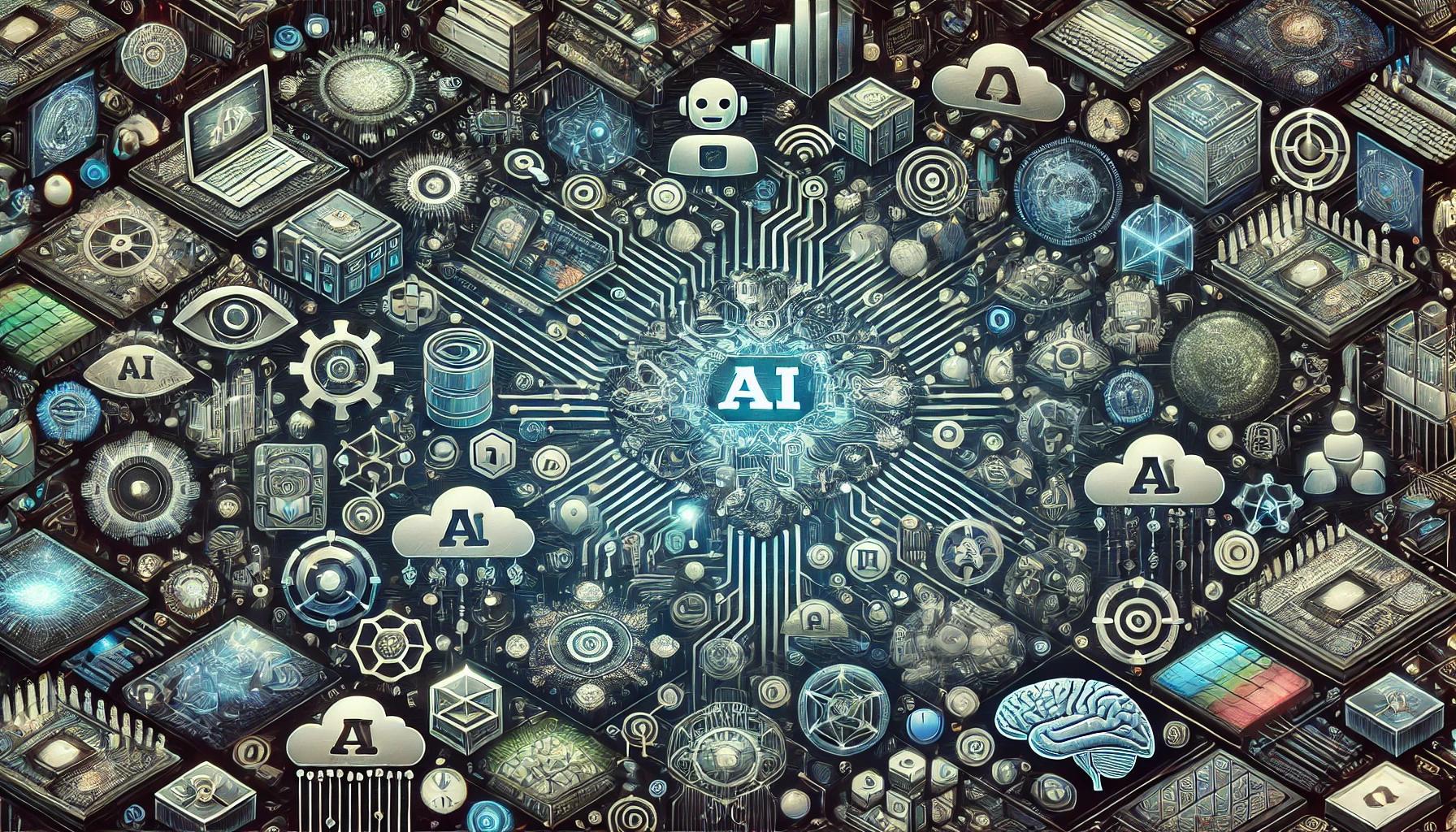AI is unlocking transformative possibilities across industries. As part of their ongoing efforts to drive portfolio company growth and source attractive investments, Delta-v is keenly focused on leveraging the benefits of artificial intelligence and participating in this wave of growth across their investment sectors.
Kirk Moore, Data Scientist at Delta-v, spearheads Delta-v’s AI initiative and for this piece, collected insights from AI experts in the Delta-v network on how AI is broadly affecting technology investments, and how it specifically impacts Delta-v’s investment sectors of infrastructure software, vertical software, CxO software, and cloud services.
AI Deployment Overview
The Inception of High-Value Generative AI
In the past, most AI use cases relied on narrow, purpose-built models; they involved training models for specific tasks using labeled data—like Zillow estimating housing prices, Amazon making product recommendations, or the post office sorting mail based on character recognition. These models are useful but limited to their specifically designed use case.
The new generation of Generative AI large language models (LLMs like Chat-GPT, Claude, and others) train on unstructured data to learn underlying patterns and structures in the data and create new content across a large variety of different problems. Companies can run inference against the models for many use cases without having to train them from scratch. Outputs are probabilistic rather than deterministic. Users can interface with a single model in natural language to work on a variety of tasks, from legal document review to computer programming questions to image generation.
Training vs. Leveraging a 3rd Party Model
Developing foundational models is very costly in terms of talent, data, and compute, so most companies choose to leverage existing foundational models via an API, similar to how companies build on top of third-party cloud infrastructure. To solve problems quickly and drive efficiency or revenue, leveraging third-party models gets youfurther faster.
In some cases, companies may want to train custom models, but this likely won't involve building a new foundational model. Instead, fine-tuning an existing model or training a narrow model for a specific use case will be more cost-effective. Companies should start by seeing how far they can get with prompt engineering before investing in fine-tuning or custom model development.
Main Generative AI Use Cases
- Analysis & Categorization: Ingesting, analyzing, and structuring data to extract insights and organize information. Examples include summarizing key skills from resumes, categorizing customer feedback by sentiment, or analyzing and bucketing product reviews.
- Generation & Creation: Generating new content and creations, such as writing marketing copy, creating personalized product descriptions and websites for different audiences, generating stock photos, or assisting with software development.
- Interactive Agents: Engaging in back-and-forth dialog via chatbots and virtual assistants to answer questions, troubleshoot issues, and complete tasks by combining analysis and generation capabilities.
- Autonomous Agents: New use cases are emerging with autonomous AI agents that can complete tasks independently by combining multiple skills and capabilities. For example, an AI agent could be tasked with growing a company's LinkedIn following by analyzing target audiences, generating content, and autonomously executing a multi-channel digital marketing campaign.
Understanding these concepts is important for understanding the AI use cases applicable across Delta-v’s investment sectors.
Evolutionary vs. Revolutionary AI
As companies consider implementing use cases, differences will invariably arise in the impact and scope of AI initiatives. There is an old adage about how people tend to overestimate the effect of technology in the short run and underestimate the effect in the long run. Even with the unprecedented user adoption rates of ChatGPT and similar models, people are probably still overestimating the impact of generative AI in the short-run. It is important to remember these are still the early days of generative AI.
Two types of changes that can be expected to occur as a result of AI:
- Incremental changes will happen relatively quickly. These include use cases where AI is layered on top of existing processes—like using AI for document review or customer service chatbots.
- Drastic changes that fundamentally transform processes will happen more slowly. These use cases involve rethinking an entire business process or model given the new capabilities of AI—for example, personalizing education with AI tutors.
In the short run, all businesses should look at where implementing AI can improve existing operations.
In the long run, it’s likely that more businesses will undergo drastic changes. Some of these changes have already come to fruition in how companies treat AI as a workforce multiplier. Sam Altman has speculated on the possible near future of companies adding 10,000 people in the form of AI agents, for the cost of hiring 10 humans.
Identifying AI Use Cases to Implement
There are potential use cases for AI up and down any given business and prioritizing where to start can be difficult.
A lot of companies should start with the traditional consultant lens: identifying the potential use cases and how much each will cost, versus their potential benefit. Every organization should start in on the use cases in the low-cost and high-benefit quadrant. For example, implementing AI in customer support use cases is commonly easy to implement and comes with cost savings or increased revenue.
Here are three tips from experience on how companies should drive AI use case adoption in their organization:
- Understand that the last mile of implementation is often very hard. You need the energy and buy-in within an organization to make your use case work.
- Be honest about whether you’re using AI because you can, or because it’s the right tool for the job. Traditional ways of solving a lot of problems still work better than using AI just to call your solution AI-enabled.
- It’s important to get started on implementing and leveraging AI. From a talent and change-management perspective, delays will just beget delays. Start building the organizational muscle of leveraging AI early so you have the foundation for future growth.
The Impact of AI on Valuations
The impact of generative AI is like the impact of the personal computer: you didn’t have to be a PC company in order to see the benefits of leveraging computers. Most companies can see massive benefits from using AI to drive efficiency internally without having to build their own proprietary models.
For example, if you’re competing against a company with 1,000 employees doing manual entry, you wouldn’t try to compete today by hiring. You can improve on your EBITDA and present a compelling case to investors by leveraging AI for that work internally.
Many companies slap an AI label on their product in hopes of reaping the reputational benefits. A more reasoned approach involves implementing AI judiciously in ways that either drive efficiency with internal use cases or enhance customer value with external use cases.
AI in Infrastructure Software
AI-enabled Opportunities in Infrastructure Software:
- Code Generation and Review: AI is increasingly used to assist developers with coding tasks - from making intelligent code suggestions as developers type, to automatically generating code snippets based on natural language prompts, to identifying bugs and optimizations during code review. Infrastructure software that touches the software development lifecycle can embed these AI-powered capabilities.
- Enabling Intelligent Interfaces: Rather than dashboards and interfaces that require teams of specialized admins and analysts to operate, AI can enable more intelligent and intuitive user experiences that empower end users directly. For example, a web analytics platform could use AI to automatically surface key insights and optimizations directly to marketers and product managers.
- Greenfield Opportunity for AI Infrastructure and Developer Tools: With the rapid emergence of generative AI, a new ecosystem is forming to provide tools and platforms to build, deploy, monitor, and maintain AI applications. This includes model monitoring, vector databases, data labeling, AI testing, and more. There is now greenfield opportunity for new infrastructure companies to support the modern AI stack.
- Protecting Against AI-Enabled Cybersecurity Attacks: While AI has potential for cybersecurity use cases, it also gives new capabilities to people with malicious intent. Companies are thinking about how theirattack surface changes and what tools they need to remain secure.
Where Delta-v portfolio companies in infrastructure software are using AI:
- Security operations company Arctic Wolf commissioned a survey of over 800 cybersecurity decision makers on the future of AI in cybersecurity, finding value in a hybrid AI approach that combines human expertise and machine learning.
- Cyber-physical systems protection company Claroty’s AI-powered analysis engine classifies assets, provides security insights, and recommends actions completely out-of-the-box.
- Application monitoring and analytics platform LogRocket created an AI tool Galileo which combines machine learning algorithms and large language models to provide customers with alerts and actionable insights to resolve the most important issues on their platform
AI in Vertical Software
AI-enabled Opportunities in Vertical Software:
- Building Industry-Specific Chatbots and Agents: Conversational AI chatbots and process automation agents that are pre-trained on industry-specific data, taxonomies, and best practices can provide more relevant and contextual interactions. For example, an AI assistant product for InsurTech companies can be trained on all the specific coverage options, claims procedures, and requirements, applicable regulations, etc. that are relevant to its users.
- Potential Impact In Document-Heavy Verticals: For example, there’s a proliferation of tools in the legal space for legal document review, case generation, and other use cases. Due to the amount of text and documentation involved in the legal profession, insurance, and health care, certain verticals lend themselves well to generative AI use cases.
Where Delta-v portfolio companies in Vertical Software are using AI:
- Retail decision platform EDITED released an AI summary feature that generates insights, e.g., highlighting assortment gaps or heavily discounted items, allowing retailers to quickly digest and take action on crucial information.
- Sports operating system platform Teamworks’s Influencer content management system uses AI to automatically tag logos, jerseys, and faces, create personalized galleries, and notify athletes when they are tagged.
- Online food ordering platform ChowNow partnered with SoundHound to enable restaurants to answer every inbound customer call or text using AI.
AI in CxO Software
AI-enabled Opportunities in CxO Software
- Deploying AI as An Agent: Everyone can be a manager with AI and have agents that can go do the busy work for them. CxO solutions which are AI-enable can help leaders offload tasks to these AI agents that they previously would have required headcount for. For example, rather than a Head of Sales tasking SDRs with generating leads, they might instead deploy AI for entire SDR workflows.
- Becoming Tools In Agentic Workflows: Conversely, solutions in the CxO space should be thinking about how they can enable themselves as tools within an agentic workflow—so that when the proliferation of AI in the workplace happens, it is easy for both human users and AI agents to access functionality. For example, if your tool is configured to help people conduct interviews, it will be important to ensure your 7 tool allows AI agents to conduct interviews in the future.
- Replacing Text and Conversation-Heavy Tasks: There are lots of use cases that AI can be deployed for in this space, from sales automation to recruiting. AI does particularly well with tasks that are text-heavy, but it’s about enabling CxOs to make the best use of their time.
Where Delta-v portfolio companies in CxO software are using AI:
- CRM platform Iterable’s AI suite enables brands to automatically segment customers by brand affinity, optimize message channels and send times, predict conversion, and generate copy and customer journeys.
- Employee listening and people analytics platform Perceptyx developed an AI Insights Engine which uses natural language processing to analyze unstructured employee feedback and generate personalized insights and recommendations.
- Hiring and assessment software provider HireVue’s Conversational AI assistant helps candidates match their skills with available job opportunities.
AI in Cloud Services
AI-enabled Opportunities in Cloud Services are using AI:
- Highly Scaled Use Cases: for example, if previously you needed to hire freelancers to go talk to 10,000 companies to data harvest, you can deploy AI in an agentic way to improve the efficiency of your approach to consulting services.
- Data Integration and Processing: AI can assist cloud services teams with data integration, cleansing, mapping, and processing tasks, reducing manual effort and enabling more advanced data transformations at scale. Previously, data mapping was a strenuous activity and now AI is especially valuable when dealing with large volumes of unstructured or siloed customer data.
- Expanding the Promise of RPA Outside of IT: previously, RPA tools were within the IT department and relied on a complete understanding of the entire business process. Now, business users can leverage AI to automate processes—it’s giving IT-like capabilities to people outside the IT department and creating a new customer
Where Delta-v portfolio companies in Cloud Services are using AI:
- Marketing cloud consultancy OSF Digital’s developer productivity platform AllAi goes beyond code generation to provide comprehensive support for developers, e.g., code explanations, unit tests, bug fixing, and human-like code review. AllAi started as an internal productivity tool for the OSF Digital team but is now available to customers.
- Intelligent automation consultancy Tquila Automation’s Conversational AI technology, in partnership with 8 DRUID AI, adds a conversational layer to automation to save time and lower cost, enhance user experience, improve quality, and boost engagement.
Delta-v’s Perspective
The impact of artificial intelligence on technology companies across sectors is just beginning to be felt. Delta-v is committed to an approach anchored in enthusiastic adoption and engagement with these tools, balanced with an understanding that the opportunity will shift as the technologies and users mature.
AI has added an incredible and accessible tool to everyone’s toolbox. It’s a computer that understands what people want in their own language. It’s incumbent on every business to find a way to deploy AI to drive value in their organization and for their customers.



